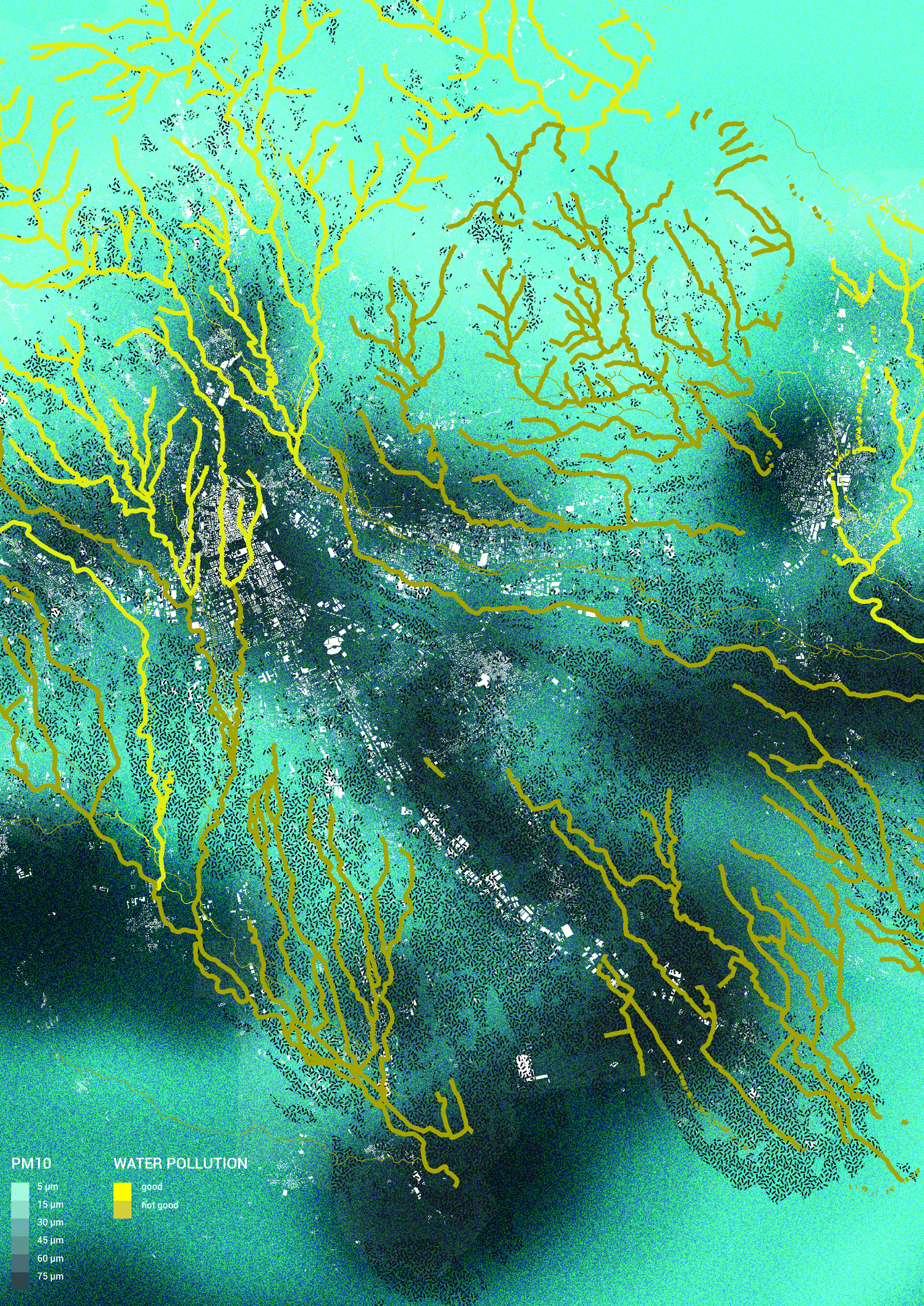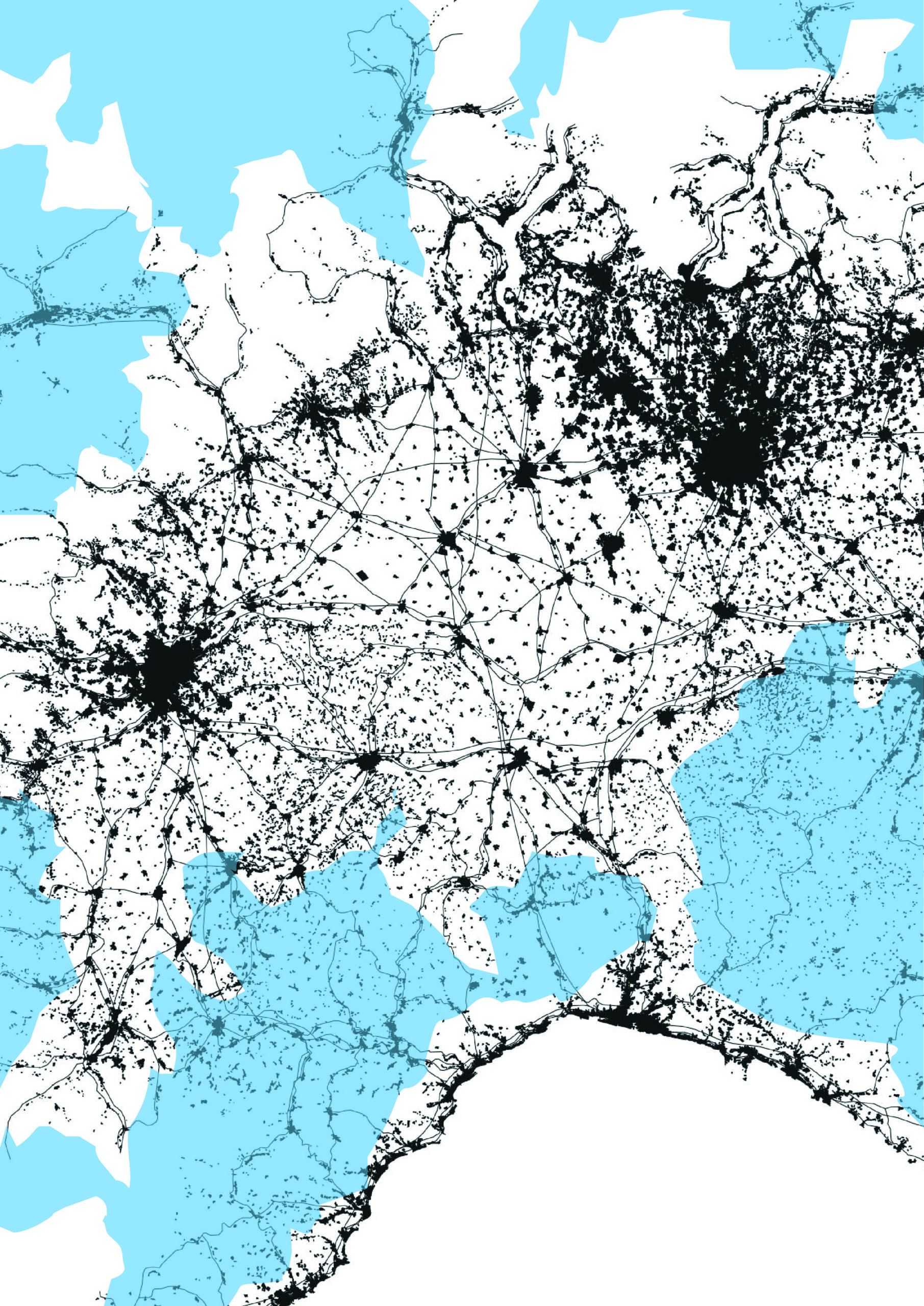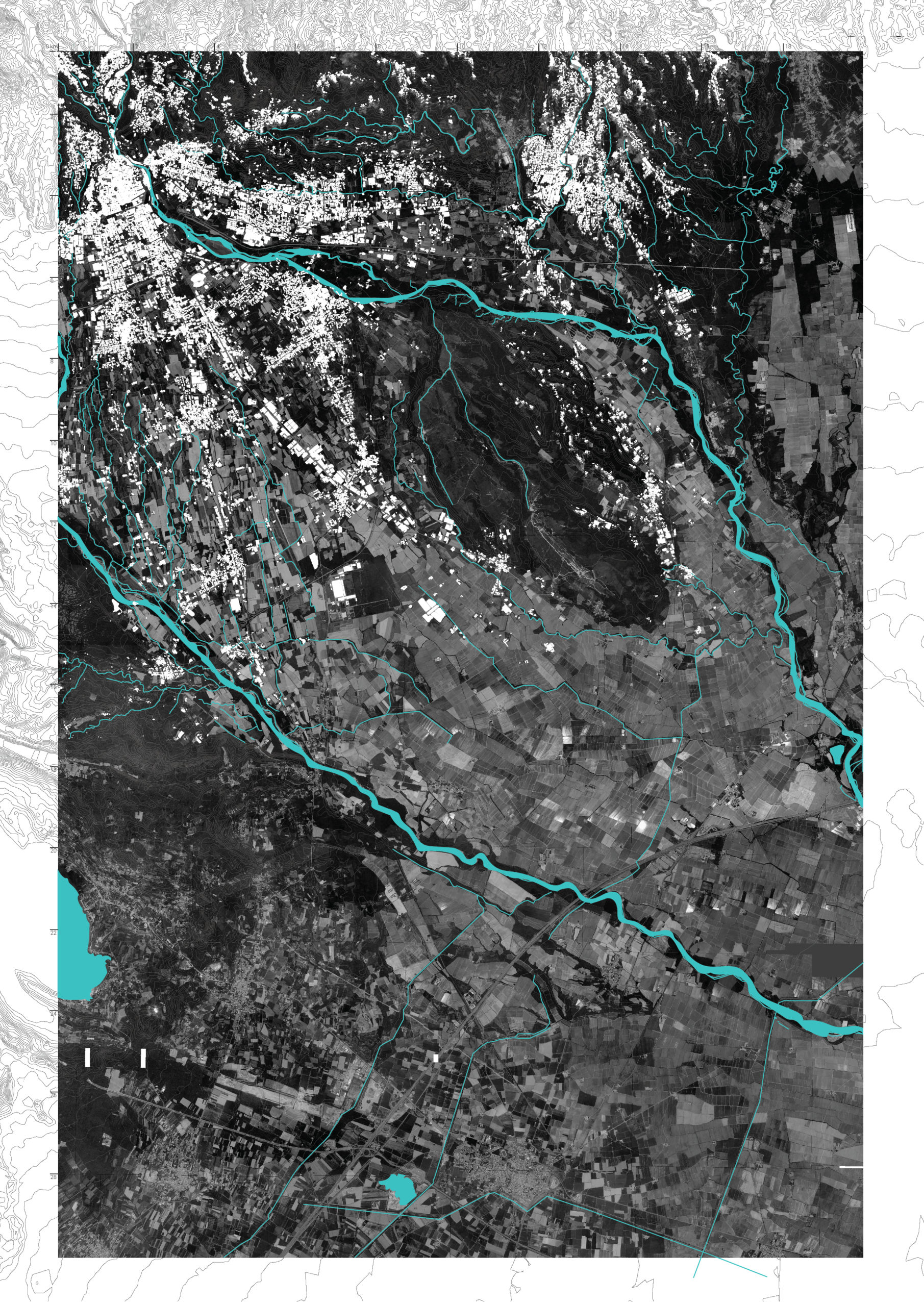Medial Territories
In medial territories, natural and built environment exist in fragile balance. The case–study demonstrates that maintaining such a tension over the years is an answer to deal with the Climate Change
di: Michele Cerruti But


di: Michele Cerruti But


The “State of Exception” caused by a pandemic is solely the last phase of the impact of techno–capitalist acceleration on planetary urbanization. As a result, urban perception has shifted from physical interaction to digital proximity, thus revealing a new dimension in the western world: medial territories. Despite a widespread notion which describes the times we live in as “the age of the virus” and hopes to witness an overhaul of contemporary society, contrasting literature suggests that the Anthropocene is also to be considered as the dawn of the “Health Age”.
In the Health Age, the principle political and economic activities lay emphasis on individuality: communal life and societal organisations assume a peripheral role as interpersonal wellbeing is generally affected by the distance technology creates between people. During the current pandemic and especially in the Accelerated End of Western Modernity, technology is having a detrimental effect on society as a whole as it reinforces social injustice and the capitalist ideal.
Here, quarantine measures have two main consequences: they minimise differences in planetary urbanisation and shift urban perception from physical proximity to the digital sphere. At the same time, densely populated cities have evolved by relying on a new kind of digital life heavily intertwined in the domestic sphere, diffuse territories redefine their urban fabric as an automated platform buried in the countryside1.

Medial Urbanization
Many influential authors have described the present times as the “Urban Age”2. Cities are the future of the planet and from a statistical standpoint (more than half of the world’s population lives in cities), they determine economic and environmental policies which are then subdivided into urban and rural development. The concept of the “Horizontal Metropolis” can resolve this modernist dichotomy in a sort of paradox in which the horizontal development interprets urbanity as a shared platform for the entire territory3. On the contrary, “The Planetary Urbanization” focuses on the urbanization process rather than the city itself, “an obsolete analytical social science tool”, and defines the contemporary territory as a single “worldwide urban fabric” in the process of making4.
While these theories serve to illustrate this chaotic global phenomenon, they do not always grasp the current specificity and post-pandemics variability. Europe is highly polarized, for instance, as large metropolitan areas, a impenetrable network of subaltern, intermediate areas and internal peripheral territories create a highly hierarchical space. Beside a vast array of projects and trends, in general local and European policies do not support the notion of horizontal planning and cities fight to promote themselves with competitive marketing campaigns5.
By focusing on processes and changes rather than objects and ideas,6 there is a point to be made that the “State of Exception” caused by the current pandemic7 is accelerating urbanization by rapidly reducing differences between distinctive urban conditions; a matter that largely depends on combining digital and physical dimension and on mediation, evoking the age-old debate on Technics8. Although a succession of crises at the beginning of the century led to an uneven landscape, the lockdown has created a shared experience, as regards to the cramped apartments in the densely populated metropolitan areas in which Existenz Minimum moulds your freedom, as well as the hybrid spaces of the transitional territories where natural and built environment merge seamlessly. This specific process is what can be defined as medial urbanization as it widely depends on Technics mediation.

Mediated urbanity
Nowadays people generally accept to work, study, live and engage in online activity much more than before the lockdown. We watch a conference filmed in New York, enjoy a lecture series organised by an independent art gallery in Spain, have virtual sex, listen to a radio-show broadcasting from Ivrea, fall in love with an exhibition in Karlsruhe, have a meeting with people from Mâcon or Arnhem, teach classes thanks to videoconference software, work from the comfort of our own homes, hire employees from the four corners of the world without even meeting them. The lockdown not only turned online life into an everyday occurrence but made it profitable too and on the surface also environmentally sustainable.
This post-human condition has a strong impact on European countries: because of the quarantine, many people returned to their home–towns, leaving the big cities half-empty. While students dispersed across the globe and workers returned to thetranquillity of their family homes in the countryside, geographical areas discovered a new economic and social balance by reducing the domination of the metropolis and at the same time promoting horizontal relations. Rather than accelerating urban polarization, the present pandemic has democratised European society: as the sanitary emergency has made it impossible to move from place to place and meet people, and urban life has evolved into a digital network which functions thanks to cloud storage and video–conferencing tools, during the lockdown both the dense urban environment and the diffuse city have had the same access to urbanity. Density and proximity are no longer aspects of urban life as they have rapidly been replaced by wi-fi speed and quality. What really matters is the quality of the domestic sphere and its connection to open spaces: as Appadurai states, urbanity depends on capabilities and during the lockdown it has definitely concerned having access to a rich lifestyle over density: in post-digital territories having access to the urban fabric is mediated by digital dispositifs9 and spatial justice depends on spatial capital, which is richer outside of the dense urban tissues10. This newly–found urban richness lies outside of the metropolis and to a certain extent, this is why we can affirm that the new urban is medial and an efficient society relies on interaction rather than on physical proximity.

Medial Territories
Medial urbanization affects the dense metropolis only moderately, however it has a vast impact beyond the city itself; this is the revenge of an undetermined medial territory with unclear boundaries similar to a post-colonial platform, in which rural subaltern spaces resemble the automated urban commons of Late Western Modernity. We consider this process to be medial, not only because of its dependency on Technics mediation, but also because it represents the majority of European territories and because such an indeterminate space lies between the crowded metropolitan centres and peripheral internal areas: apart from the main cities, Europe is primarily composed of mediated urbanity growing from the roots of diffuse urbanization.
The outskirts of the town of Biella as well as the surrounding areas of the cities of Turin and Milan, in North–West Italy, form the main case study of this article; the result of group–work based on an urbanistic approach combined with a sociological analysis. It is a qualitative study on the current socio-economic trends and their territorial implications, accelerated by the pandemic. Biella serves as a symbol of a promising European medial metropolis which could redefine the Health-Age and the planetary urbanization in the western world.

Medium project
In general, the design tools employed to plan cities are an inadequate answer for the spatial issues of medial territories. As urbanism is intrinsically linked to the process of planetary urbanization, its tools and vocabulary directly depend on metropolitan narratives. Issues such as mobility, welfare, commons, participation, global-local, production, services, public transports and green spaces mainly suggest that Urbanism primarily focus on metropolitan areas. It is clear however that since media–driven interactions highlight the problems people face daily, the practice of designing medial territories requires a complete overhaul both in terms of concepts and language. Moreover, this might prompt the decision–makers to find alternative ways to share resources or use public transport. In fact standard collective means of transport such as buses, trains, car and bike-sharing are not effective in this scenario: public transport companies often go bankrupt in medial territories and transport sharing concepts are not widespread. Participation and commons should also be reanalysed under the lens of mediality: people and communities tend to disperse in different directions at the same time and their medial urbanity accentuates this phenomenon. Special attention also needs to be payed to different locales and their relations: inter-locality rather than trans-locality, scaling-up and replicability represents, for instance, a necessary pattern-shift. The way people live their lives is radically different too: private and public are intrinsically linked while the digital and physical spheres blend seamlessly redefining alternative flows, temporalities, individual as well as collective idiorrhythms.
These examples demonstrate that design practices need to reflect the current debate on Medial Territories: as they form the majority of Europe, Urbanism should specify its approach, identify alternative design methods and revise its language. Such an analysis underlines at least two main lines of work: first of all the spatial debate. Not only because space is the focus of territorial development but most importantly because it is the main aspect which determines the difference between metropolitan and medial territories. As previously illustrated, the quality of the urban condition primarily depends on spatial capital, and this must be properly designed by taking into consideration its diffuse specificity. In second place comes the medial controversy. As processes of urbanization tend to blur the boundaries of other aspects and not just exclusively physical proximity, territorial projects must take into account the central role played by the dispositifs and their connection to space. The ensuing territory is intensely mediated and this automation has a deep impact both on the individuals and the community as a whole: to counteract the devastating effect of an automatic society11, urbanism should incorporate spatial design and linguistics into a new territorial project.
1 This contribution is part of a research began a couple of years ago, which focuses on “intermediate territories” in Italy. The lockdown that occurred during the pandemic prompted me to revise this analysis to include a more articulated reflection on the role of Technics in the Urbanization process. This research was also the focus of the Climate Urbanism Design Unit at the School of Architecture for Sustainable Design, Politecnico di Torino (Professors: Michele Cerruti But and Daniela Ciaffi). The outcome of the Design Unit is published online at the following link: https://issuu.com/michelecerrutibut/docs/cu_final_report_single_compressed. The paragraph “Spatial Issues” is entirely written by Erika Cerra and Loris Insinna.
2 See in example: Burdett R., Sudjic D. (eds.), The Endless City, London: Phaidon 2007; Burdett R., Sudjic D. (eds.), Living in the Endless City, London: Phaidon 2011; Burdett R., Sudjic D. (eds.), Shaping Cities in an Urban Age, London: Phaidon, 2018.
3 Viganò P., Cavalieri C., Barcelloni Corte M. (eds.), The Horizontal Metropolis Between Urbanism and Urbanization, Springer: Wien 2018; Viganò P., Cavalieri C. (eds.), The Horizontal Metropolis. A Radical Project, Zurich: Park, 2020.
4 “Consequently, despite its continued pervasiveness in scholarly and political discourse, the category of the “city” has today become obsolete as an analytical social science tool. Correspondingly, it is no longer plausible to characterise the differences between densely agglomerated zones and the less densely settled zones of a region, a national territory, a continent, or the globe through the inherited urban/rural (or urban/non-urban) distinction. Today, the urban represents an increasingly worldwide condition in which political-economic relations are enmeshed.
This situation of planetary urbanisation means, paradoxically, that even spaces that lie well beyond the traditional city cores and suburban peripheries—from transoceanic shipping lanes, transcontinental highway and railway networks, and worldwide communications infrastructures to alpine and coastal tourist enclaves, “nature” parks, offshore financial centres, agro-industrial catchment zones and erstwhile “natural” spaces such as the world’s oceans, deserts, jungles, mountain ranges, tundra, and atmosphere — have become integral parts of the worldwide urban fabric” (Brenner N., Schmid C., “Planetary urbanization,” in Gandy M. (ed.), Urban Constellations, Berlin: Jovis, 2012, 10-13).
See also: Brenner N. (ed.), Implosions/Explosions: Towards a Study of Planetary Urbanization, Berlin: Jovis 2013; Brenner N., Schmid C., “The ‘urban age’ in question”, International Journal of Urban and Regional Research, 38/3, 2014: 731-755; Brenner N., “Debating planetary urbanization: for an engaged pluralism,” Environment and Planning D: Society and Space, April 2018.
5 Such a reflection is also at the center of contemporary Italian debate on “Internal Areas”. See for instance the limits and the opportunities connected with the National Strategy for Internal Areas (http://www.programmazioneeconomica.gov.it/2019/05/23/strategia-nazionale-delle-aree-interne/) and the reflections of a large group of scholars within the book: De Rossi A. (ed.), Riabitare l’Italia. Le aree interne tra abbandoni e riconquiste, Donzelli, Roma 2018.
6 I specifically refer to the wide debate regarding processes and change as the cornerstones of reality (Whitehead A., Process and Reality, Macmillan, New York 1929; but also Nail T., The Figure of the Migrant, Stanford University Press, 2015).
7 Agamben G., State of Exception, The University of Chicago Press, 2005.
8 Campagna F., Technic and Magic: : The Reconstruction of Reality, Bloomsbury, London 2018; Morozov E., The Net Delusion: the Dark Side of Internet Freedom, PublicAffairs, NY 2011.
9 Regarding the concept of dispositif is obviously necessary to see: Foucault M., “The Confession of the Flesh” (1977) interview in Gordon C. (ed.), Power/Knowledge Selected Interviews and Other Writings, 1980: pp. 194-228; Agamben G., What is an Apparatus? And Other Essays, Stanford University Press, 2009.
10 Lévy J., “Capital spatial”, in Lévy J., Lussault M., Dictionnaire de la géographie et de l’espace des sociétés, Paris, Belin 2003.
11Stiegler B., Automatic Society. The Future of Work, Polity Press, Cambridge 2016.
Image 1
SPATIAL ISSUES: CLIMATE CHANGE
In medial territories, natural and built environment exist in fragile balance. The Biella case–study demonstrates that maintaining such a dynamic tension over the years is an effective answer to deal with the effects of Climate Change.
Mapping the implications of Climate Change in medial territories is no easy feat: data is often incomplete, fragmented and not cohesive and the territory in question is often unaware of its state as the data is seldom linked to the overall situation. However, several key players are pushing towards innovative solutions in the production system, especially in the textile and agricultural sectors. These inputs are precise and more effective than political-administrative solutions.
The map shows the current air and water quality in the area which surrounds Biella. Although heavy industry and the excessive number of private vehicles generally represent the most polluting sectors, the invisible “green” digitalization and the cloud storage of medial cities spread elsewhere their devastating impact on energy consumption and global warming.
Image 2
SPATIAL ISSUES: MOBILITY
Mobility and accessibility are two crucial, contemporary geopolitical and ethical issues, which affect environmental and societal rights on both local and global levels. The predominant means of transport in medial territories, private cars are an individual answer to large distances and uneven morphology. Public means of transport are largely inadequate mainly because of the obsolescence of infrastructure, mismanagement and the high dependency on hierarchical fast-speed networks. Although the blended combination of digital/physical life in those areas reveals a different type of urbanity, the lack of an alternative to public transport highlights a harsh mobility injustice which has a negative impact on individuals, the human rights of the entire society, environmental pollution and climate.
A bottom-up, communal transport systems is a substantial yet feeble answer to this problem. In fact, the majority of people only use public transport to cover long distances and reach big cities: proximity and accessibility remain important issues.
Image 3
SPATIAL ISSUES: BORDERS
Although mediality firmly depends on the intermediate geographical position between peripheral and metropolitan areas on the contrary, the actual borders of medial territories are a dynamic threshold. In fact, medial boundaries are not only defined by territorial morphology or their administrative division, but also by complex productive, commercial and societal relations.
The medial condition itself highlights a hybrid territory which depends on homogeneous and coherent forms of living rather than political issues. By transcending rigid geographical confines and crossing both regional and national borders, the digital dimension creates flexible and broader boundaries: in this way, medial territories also redefine the very idea of Europe.
The map shows the connection among the metropolitan areas of Turin and Milan and the hybrid medial territory around Biella. This homogeneous situation relies on the special relationship that exists between the physical and medial life, thus producing an uninterrupted territory with an extremely different urban life.
Image 4
SPATIAL ISSUES: THE NATURAL ENVIRONMENT
Medial territories are key if we want to preserve the metropolis as an epicentre of wealth, especially if we consider its many natural resources and its potential in terms of energy production. On one hand, these fertile lands have generous mineral resources and their effective water and energy networks are a knot for both the agricultural production and the industry. On the other, the region’s many untainted natural areas are a boost to the local tourist economy. Nonetheless, this subaltern role highlights a type of territorial culture which centres on extractivism. As the large cities expand thanks to external products and resources, medial territories are abused and exploited.
In these territories however the automation accelerated by the current pandemic increases the access to services and job opportunities and overthrows this subservient relationship by joining the urbanization process to the natural environment thus creating a new way of life.
Image credits
All the images in this article were produced by Erika Cerra and Loris Insinna in the Climate Urbanism Design Unit at the School of Architecture for Sustainable Design, Politecnico di Torino.
Pubblicato il: 22.01.2021